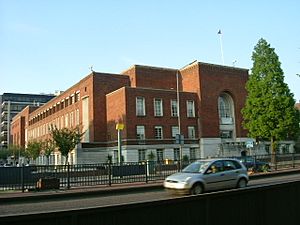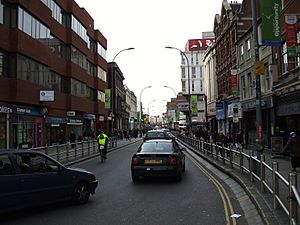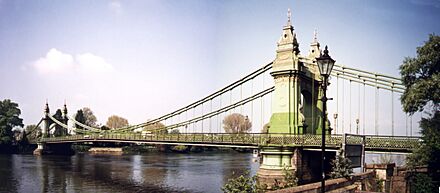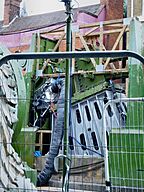Hammersmith facts for kids
Quick facts for kids Hammersmith |
|
|---|---|
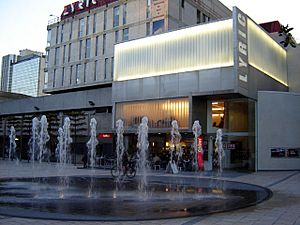 Lyric Theatre, Hammersmith |
|
| Population | 95,996 (2020) |
| OS grid reference | TQ233786 |
| • Charing Cross | 4.3 mi (6.9 km) ENE |
| London borough | |
| Ceremonial county | Greater London |
| Region | |
| Country | England |
| Sovereign state | United Kingdom |
| Post town | LONDON |
| Postcode district | W6 W14 |
| Dialling code | 020 |
| Police | Metropolitan |
| Fire | London |
| Ambulance | London |
| EU Parliament | London |
| UK Parliament |
|
| London Assembly | |
Hammersmith is a lively area in West London, England. It is about 7 kilometers (4.3 miles) southwest of Charing Cross, a famous spot in central London. Hammersmith is the main administrative center for the London Borough of Hammersmith and Fulham. It is also recognized as one of the 35 most important centers in Greater London.
This area is surrounded by other well-known places. To the north is Shepherd's Bush, to the east is Kensington, and to the west is Chiswick. To the south, it borders Fulham, and together they sit on the north bank of the River Thames. Hammersmith is a major business and job hub in west London. For many years, it has also been a significant center for London's Polish community. It is a very important place for travel in west London. You can find two London Underground stations and a large bus and coach station at Hammersmith Broadway.
Contents
- What Does the Name Hammersmith Mean?
- A Look at Hammersmith's Past
- Hammersmith's Economy and Shops
- Cool Buildings and Architecture
- Fun Things to Do in Hammersmith
- Getting Around Hammersmith: Transport
- Hammersmith Bridge: A Landmark
- Hammersmith in Books and Music
- Famous People from Hammersmith
- See also
What Does the Name Hammersmith Mean?
The name Hammersmith might mean "place with a hammer smithy or forge." A smithy is a workshop where a blacksmith works with metal. In 1839, Thomas Faulkner suggested the name came from old Saxon words. He thought Ham meant a settlement, and hythe meant a landing place by a river. This would make sense because Hammersmith is right by the River Thames.
In 1922, another idea was that the first part of the name came from a person's name, like Heahmaer or Hæmar. The second part, -myðe, could be an old Anglo-Saxon word meaning where two rivers meet. This is because Hammersmith Creek used to join the Thames here. The earliest way the name was spelled was Hamersmyth in 1294. Other spellings included Hameresmithe in 1312 and Hamyrsmyth in 1535. The spelling Hammersmith became common by 1675.
A Look at Hammersmith's Past
Hammersmith was once a small part of the larger parish of Fulham. It became its own independent parish in 1631. In the early 1660s, the first church in Hammersmith was built. This church later became St Paul's. It was built by Sir Nicholas Crispe, who owned a brick-making business in Hammersmith. The church had a special memorial to Crispe. It also had a bronze statue of King Charles I. In 1696, Sir Samuel Morland was buried there. The church was completely rebuilt in 1883. However, the old memorial and statue were moved to the new church.
In 1745, two Scotsmen, James Lee and Lewis Kennedy, started the Vineyard Nursery. This was a large plant nursery covering over six acres. Over the next 150 years, this nursery brought many new plants to England. These included the beautiful fuchsia flower and the standard rose tree.
In 1804, a famous legal case happened in Hammersmith. It was called the Hammersmith Ghost murder case. This case set a unique standard in English legal history.
By 1868, Hammersmith was a parish and a suburban area in Middlesex county. It had important factories, like the Osram lamp factory. The J. Lyons factory was also here, and at one point, it employed 30,000 people. During both World Wars, the Waring & Gillow furniture factory was used to build aircraft.
Hammersmith used to have its own power station. This station provided electricity to the area from the early 1900s. When the electricity industry became nationalized in 1948, the power station was taken over by the government. It closed in 1965 because it was no longer needed.
Hammersmith's Economy and Shops
Hammersmith is a busy place because important roads meet here. One main road, the A4, leads out of central London. Several smaller roads and a bridge over the Thames also come together here. The heart of Hammersmith is the Broadway Centre. This is a large commercial area with a shopping mall, a bus station, an Underground station, and offices.
King Street is Hammersmith's main shopping street. It stretches about 750 meters (820 yards) west from the Broadway Centre. It is named after John King, who was a Bishop of London. King Street has another shopping center called Livat Hammersmith. It also has many small shops, the town hall, the Lyric Theatre, a cinema, and the Polish community center. You can also find two hotels there. Other shops are located along Shepherds Bush Road to the north, Fulham Palace Road to the south, and Hammersmith Road to the east. Many offices in Hammersmith are on the eastern side of the center, along Hammersmith Road. The Ark is a unique office building south of the flyover.
Charing Cross Hospital is a large hospital on Fulham Palace Road. It is an NHS hospital with many different departments. It also has an emergency room and teaching facilities.
Cool Buildings and Architecture
The "Ark" office building was designed by British architect Ralph Erskine. It was finished in 1992 and looks a bit like the hull of a sailing ship. The Hammersmith Bridge Road Surgery was designed by Guy Greenfield.
22 St Peter's Square used to be the Royal Chiswick Laundry and the main office for Island Records. It has been turned into studios and offices for architects. It even has an award plaque from the Hammersmith Society for its conservation efforts.
Many of Hammersmith's pubs are listed buildings, which means they are protected because of their history or special design. These include the Black Lion, The Dove, The George, The Hop Poles, the Hope and Anchor, the Salutation Inn, and The Swan. Hammersmith also has two historic parish churches. St Paul's is the town's original church, rebuilt in the 1890s. St Peter's was built in the 1820s.
Fun Things to Do in Hammersmith
Riverside Studios is a place where you can watch movies, see live performances, and grab a bite to eat. It used to be a film studio and was used by the BBC for TV shows from 1954 to 1975. The Lyric Hammersmith Theatre is just off King Street.
The Hammersmith Apollo is a famous concert hall and theater. It has had different names over the years, like the Hammersmith Odeon. It is located just south of the main road junction.
The old Hammersmith Palais nightclub has been taken down. Student housing has been built on that spot.
The Polish Social and Cultural Association is on King Street. It has a theater, an art gallery, and several restaurants. Its library has one of the largest collections of Polish books outside of Poland.
The Dove is a riverside pub. The Guinness Book of Records once listed it as having the smallest bar room in the world. Famous writers like Ernest Hemingway and Graham Greene used to visit this pub. It is believed that James Thomson might have written Rule Britannia here. The narrow alley where the pub stands is the only part left of the old riverside village of Hammersmith. Most of it was removed in the 1930s. Furnivall Gardens is a park to the east. It covers the area where Hammersmith Creek and the High Bridge used to be.
You can also enjoy activities along Hammersmith's riverside. This area is for walking and has pubs, rowing clubs, and the Furnival Gardens park. Hammersmith also has a public park called Ravenscourt Park to the west. It has tennis courts, a basketball court, a bowling lawn, a paddling pool, and playgrounds.

Hammersmith is the historic home of the West London Penguin Swimming and Water Polo Club. This club was once known as the Hammersmith Penguin Swimming Club. Hammersmith Chess Club has been active since it started in 1962.
Getting Around Hammersmith: Transport
Hammersmith is on the main A4 trunk road. This road goes west from central London towards the M4 motorway and Heathrow Airport. The A4 is a very busy road for commuters. It goes over the main road junction in the area, called the Hammersmith Gyratory System, on a long bridge called the Hammersmith Flyover. Hammersmith Bridge was closed in August 2020 for people walking, cycling, and driving. This cut off the connection with Barnes to the southwest. The cast iron parts that hold the bridge's suspension system became unsafe.
The center of Hammersmith has two London Underground stations, both named Hammersmith. One station serves the Hammersmith & City and Circle lines. The other station serves the Piccadilly and District lines. This second station is part of a larger complex with offices, shops, and transport, known as "The Broadway Centre." Hammersmith Broadway is a busy area with a major bus station. The western parts of King Street are closer to Ravenscourt Park Underground station. This station is on the District line, just one stop west of Hammersmith.
Hammersmith Bridge: A Landmark
The first Hammersmith Bridge was designed by William Tierney Clark. It opened in 1827 and was the first suspension bridge to cross the River Thames. It was later redesigned by Joseph Bazalgette and reopened in 1887. In August 2020, the bridge was closed to everyone. This was because the cast iron parts holding the suspension system became unsafe. Work began in 2022 to make the bridge strong and safe again.
Hammersmith in Books and Music
Hammersmith appears in Charles Dickens' famous book Great Expectations. It is where the Pocket family lives by the river. The main character, Pip, stays with them and enjoys boating on the river.
William Morris's book News from Nowhere (1890) describes a journey up the river from Hammersmith.
In 1930, Gustav Holst composed a piece of music called Hammersmith. He wrote it for a military band, and later for an orchestra. The music shows his feelings about the area, as he had lived nearby for almost 40 years. It starts with a beautiful musical picture of the River Thames flowing under Hammersmith Bridge. Holst taught music at St Paul's Girls' School. He wrote many of his most famous works there, including his The Planets suite. A music room at the school is named after him.
Famous People from Hammersmith
Many notable people have lived in or been connected to Hammersmith.
People from the 1600s

- John Milton (1608–1674), a very famous poet.
- William Sheridan (around 1635 – 1711), a Bishop.
People from the 1700s
- William Belsham (1752–1827), a writer and historian.
- Charles Burney (1757–1817), a school teacher.
- Caroline of Brunswick (1768–1821), a princess and Queen Consort of George IV.
- William Crathern (born 1793), a composer.
- Lewis Kennedy (around 1721 – 1782), a nurseryman (someone who grows plants).
- James Lee (1715–1795), also a nurseryman.
People from the 1800s
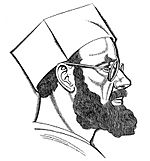
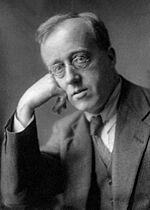
- Frank Brangwyn, an artist and painter.
- T. J. Cobden Sanderson (1840–1922), an artist and bookbinder.
- William Tierney Clark (1783–1852), an engineer who designed the first Hammersmith bridge.
- Ellen and William Craft, (1826–1891, 1824–1900), activists who fought against slavery.
- Jeanne Deroin (1805–1894), a French feminist.
- Eric Gill (1882–1940), a typographer (someone who designs typefaces) and printmaker.
- A. P. Herbert (1890–1971), a humorist.
- Gustav Holst (1874–1934), a composer who taught music at St Paul's Girls' School.
- Leigh Hunt (1784–1859), a critic, essayist, poet, and writer.
- Edward Johnston (1872–1944), a scholar known for bringing back calligraphy.
- William Morris (1834–1896), an artist, writer, and activist.
- Ouida (Maria Louise Ramé, 1839–1908), a novelist.
- Francis Ronalds (1788–1873), an inventor who built the first working telegraph in Hammersmith.
- Frederic George Stephens (1827–1907), an art critic.
- Emery Walker (1851–1933), an engraver and printer.
- Christopher Whall (1849–1924), a stained glass artist.
- Evelyn Whitaker (1844–1929), a children's writer.
- George Wimpey (1855–1913), a stonemason and businessman.
People Born Between 1900 and 1945
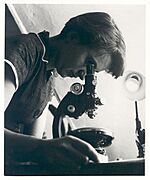
- George Devine (1910–1966), a director.
- Mary Fedden (1915–2012), an artist.
- Rosalind Franklin (1920–1958), an X-ray crystallographer who helped discover the structure of DNA.
- Jocelyn Herbert (1917–2003), a stage designer.
- Helen Mirren (born 1945), a famous actress.
- Maurice Murphy (1935–2010), a trumpet player.
- Eric Newby (1919–2006), a travel writer.
- Eric Ravilious (1903–1942), an artist.
- Tony Richardson (1928–1991), a theater and film director.
- Diana Rigg (1938–2020), an actress.
- Vidal Sassoon (1928–2012), a famous hairdresser.
- Labi Siffre (born 1945), a musician.
- Julian Trevelyan (1910–1988), an artist.
People Born Between 1946 and 2000



- Alfie Allen (born 1986), an actor.
- Lily Allen (born 1985), a pop singer.
- Richard Ayoade (born 1977), an actor and comedian.
- Bill Bailey (born 1964), a comedian.
- Sacha Baron Cohen (born 1971), a comedian and actor.
- Marcus Bent (born 1978), a footballer.
- Joe Calzaghe (born 1972), a boxer.
- Parosha Chandran (born 1969), a human rights lawyer.
- Sebastian Coe (born 1956), an athlete and politician.
- Marie Colvin (1956–2012), a journalist.
- Benedict Cumberbatch (born 1976), a famous actor.
- James DeGale (born 1986), a boxer.
- Cara Delevingne (born 1992), a model and actor.
- Emerald Fennell (born 1985), a filmmaker.
- Ralph Fiennes (born 1962), an actor.
- Emilia Fox (born 1974), an actor.
- Hugh Grant (born 1960), an actor.
- Michael Gove (born 1967), a politician.
- George Groves (born 1988), a boxer.
- Tom Hardy (born 1977), an actor.
- Miranda Hart (born 1972), an actor.
- Gary Hibbs (born 1957), a former professional footballer.
- Sophie Hunter (born 1978), a theater and opera director.
- James May (born 1963), a television presenter.
- Douglas Murray (born 1979), an author and journalist.
- Gary Numan (born 1958), a musician.
- Scott Overall (born 1983), a marathon runner.
- Stuart Pearce (born 1962), a footballer.
- Rosamund Pike (born 1979), an actress.
- Stephen Poliakoff (born 1952), a playwright.
- Imogen Poots (born 1989), an actress.
- Jacob Rees-Mogg (born 1969), a politician.
- Toby Regbo (born 1991), an actor.
- Alan Rickman (1946–2016), an actor.
- Luke Stoughton (born 1977), a cricketer.
- Estelle Swaray (born 1980), a musician.
- Juno Temple (born 1989), an actress.
- Suki Waterhouse (born 1992), an actress and model.
- Alan Wilder (born 1959), an electronic musician.
See also
 In Spanish: Hammersmith para niños
In Spanish: Hammersmith para niños



